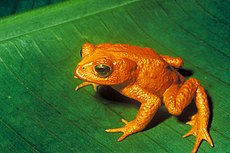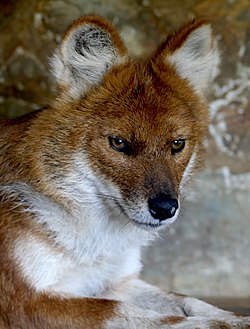User:AngelicaOn/sandbox
| Conservation status | |
|---|---|
 | |
| Extinct | |
| Threatened | |
| Lower Risk | |
Other categories | |
| (list) | |
Related topics | |
 Comparison of Red List classes above and NatureServe status below  | |
An endangered (EN)
3079 animals and 2655 plants are endangered worldwide, compared with 1998 levels of 1102 and 1197, respectively.[1] The amount, population trend, and conservation status of each species can be found in the lists of organisms by population.
Many nations have
We talk about extension when the prejudice of the container ready of the cause exclusively attributes the hand of the man with hunting, alterations of the environment, distraction of the natural habits, the contamination, the introduction of foreign species that makes them native, Etc.
Conservation status
The
Over 40% of species are estimated to be at risk extinction.
IUCN Red List

The
The IUCN Red List uses the term endangered species as a specific category of imperilment, rather than as a general term. Under the IUCN Categories and Criteria, endangered species is between critically endangered and vulnerable. Also critically endangered species may also be counted as endangered species and fill all the criteria.
IUCN categories, and some animals in those categories, include:
- Extinct: Aurochs, Bali tiger, blackfin cisco, Caribbean monk seal, Carolina parakeet, Caspian tiger, dodo, dusky seaside sparrow, eastern cougar, golden toad, great auk, Japanese sea lion, Javan tiger, labrador duck, passenger pigeon, Schomburgk's deer, Steller's sea cow, thylacine, toolache wallaby, western black rhinoceros
- Extinct in the wild: captive individuals survive, but there is no free-living, natural population. Examples: Barbary lion, Catarina pupfish, Hawaiian crow, Père David's deer, Scimitar oryx, Socorro dove, Wyoming toad
- Critically endangered: faces an extremely high risk of Yangtze river dolphin, northern white rhinoceros
- Endangered: faces a very high risk of extinction in the near future. Examples:
- Vulnerable: faces a high risk of extinction in the medium-term. Examples: Galapagos tortoise(may differ with rising tourism), gaur, blue-eyed cockatoo, golden hamster, whale shark, hippopotamus, Humboldt penguin, Indian rhinoceros, Komodo dragon(may differ with the small number of females), lesser white-fronted goose, mandrill, maned sloth, mountain zebra, polar bear, red panda, sloth bear, takin, yak
- Near threatened: may be considered threatened in the near future. Examples:
- Least concern: no immediate threat to the survival of the species. Examples: red howler monkey
United States
Endangered Species Act

Under the
Some endangered species laws are controversial. Typical areas of controversy include: criteria for placing a species on the endangered species list and criteria for removing a species from the list once its population has recovered; whether restrictions on land development constitute a "taking" of land by the government; the related question of whether private landowners should be compensated for the loss of uses of their lands; and obtaining reasonable exceptions to protection laws. Also lobbying from hunters and various industries like the petroleum industry, construction industry, and logging, has been an obstacle in establishing endangered species laws.
The
Being listed as an endangered species can have negative effect since it could make a species more desirable for collectors and poachers.[8] This effect is potentially reducible, such as in China where commercially farmed turtles may be reducing some of the pressure to poach endangered species.[9]
Another problem with the listing species is its effect of inciting the use of the "shoot, shovel, and shut-up" method of clearing endangered species from an area of land. Some landowners currently may perceive a diminution in value for their land after finding an endangered animal on it. They have allegedly opted to silently kill and bury the animals or destroy habitat, thus removing the problem from their land, but at the same time further reducing the population of an endangered species.
Currently, 1,556 known species in the world have been identified as endangered, or near extinction, and are under protection by government law (Glenn, 2006, Webpage). This approximation, however, does not take into consideration the number of species threatened with endangerment that are not included under the protection of such laws as the Endangered Species Act. According to
Over-hunting
Over-hunting and over-fishing have been a problem ever since mankind started to hunt, and it is no different today. Animals like the bald eagle, grizzly bear, American bison, timber wolf, and sea turtles have all been hunted nearly to extinction, and these are the lucky ones. Others such as the dodo, passenger pigeon, great auk, Tasmanian tiger, and Stellar’s sea cows were not as lucky as they were hunted to extinction. All of these animals started off as a food source or ones almost necessary for survival, but the need turned into greed and sport and the populations of these animals were greatly depleted. A present day example of the over-hunting of a species can be seen in the oceans as populations of certain whales have been greatly reduced. Large whales like the blue whale, bowhead whale, finback whale, gray whale, sperm whale, and humpback whale are some of the eight whales which are currently still included on the Endangered Species List. Actions have been taken to try to reduce whaling and increase population sizes, including prohibiting all whaling in United States waters, the formation of the CITES treaty which protects all whales, along with the formation of the International Whaling Commission (IWC). But even though all of these movements have been put in place, countries like Japan claim that they are whaling for “scientific” purposes and continue to harvest whales.[13] Over-hunting,climatic change and habitat loss leads in landing species in endangered species list and could mean that extinction rates could increase to a large extent in the future.
Invasive Species
Invasive species are primarily spread by human activities, often unintentionally. People, and the goods we use, travel around the world very quickly, and they often carry uninvited species with them.
Invasive species cause harm to wildlife in many ways. When a new and aggressive species is introduced into an ecosystem, it might not have any natural predators or controls. It can breed and spread quickly, taking over an area.
Higher average temperatures and changes in rain and snow patterns caused by global warming will enable some invasive plant species The introduction of non indigenous species to an area can disrupt the ecosystem to such an extent that native species become endangered. Such introductions may be termed alien or invasive species. In some cases the invasive species compete with the native species for food or prey on the natives. In other cases a stable ecological balance may be upset by predation or other causes leading to unexpected species decline. New species may also carry diseases to which the native species have no resistance.[14]
Conservation

Captive breeding
Captive breeding is the process of breeding rare or endangered species in human controlled environments with restricted settings, such as wildlife preserves, zoos and other conservation facilities. Captive breeding is meant to save species from extinction and so stabilize the population of the species that it will not disappear.[15]
This technique has worked for many species for some time, with probably the oldest known such instances of captive mating being attributed to menageries of European and Asian rulers, an example being the
Private farming
Whereas poaching substantially reduces endangered animal populations, legal, for-profit, private farming does the opposite. It has substantially increased the populations of the southern black rhinoceros and southern white rhinoceros. Dr Richard Emslie, a scientific officer at the IUCN, said of such programs, "Effective law enforcement has become much easier now that the animals are largely privately owned... We have been able to bring local communities into the conservation programmes. There are increasingly strong economic incentives attached to looking after rhinos rather than simply poaching: from Eco-tourism or selling them on for a profit. So many owners are keeping them secure. The private sector has been key to helping our work."[16]
The also worry about the role of the animals as a sustainable solution in the humane and development programs. The life of the animals in the persons are fundamentally linked. The estimation is the 10 million people in the world depend on animals for correct a limitation, having a job, staying healthy, also for companion as a pet. For consequence, the protection of animals must develop a more centralized in any response effectively to disaster.
Conservation experts view the effect of China's turtle farming on the wild turtle populations of China and South-Eastern Asia—many of which are endangered—as "poorly understood".[17] Although they commend the gradual replacement of wild-caught turtles with farm-raised turtles in the marketplace (the percentage of farm-raised individuals in the "visible" trade grew from around 30% in 2000 to around 70% in 2007),[18] they worry that many wild animals are caught to provide farmers with breeding stock. The conservation expert Peter Paul van Dijk noted that turtle farmers often believe that wild-caught animals are superior breeding stock; turtle farmers may therefore seek and catch the very last remaining wild specimens of some endangered turtle species.[18]
In 2009, researchers in Australia first coaxed southern bluefin tuna to breed in landlocked tanks, raising the possibility that fish farming may be able to save the species from overfishing.[19]
Countries with endangered animals
In the world hundreds of thousands of species is lost, many of them even before being discovered by science. Thus, not only the biological variability, but also genetic diversity, sources of livelihoods for future generations is lost. An endangered species is a species that may become extinct in the near future. Through the history of evolution, millions of species have disappeared due to natural processes. In the past 300 years, however, humans have increased the extinction rate per thousand.
For all the natural plant and animal species, living is a daily hazard, must guard their peers, especially the most powerful predator that exists on Earth, man. Ecological disasters, deforestation and other consequences of human action causing damage to the food chain. In today's world, the extinction of animal species are less directly related to escazes food or pollution, as with direct violent actions (unregulated hunting and illegal trade of wild species) or indirect (the introduction of exotic species in certain environments, competing for one or more individuals or resources with native and locally adapted).
According to conservationists, wildlife predation has grown rapidly and is now estimated that one species disappears every 15 minutes. For nature, the worst that can happen is the extinction of species, and with that it endangers the necessary balance in any ecosystem. This natural chain, each species needs the other to survive. The accelerated destruction of habitat is pretext of developing sustainability parameters, condemned to extinction to biodiversity potential life whose future lies. And while this attitude represents an anthropocentric stance glance, the man in its search for new alternatives, can not deviate from that vision, otherwise the very existence would have no reason for being. Introducing these concepts to the philosophy of communication, we consider vital to contribute to the protection of natural resources, spreading the potential of the rich fauna.
Gallery
-
The endangered island fox
-
The endangered sea otter has a relatively large population
-
American bison skull heap. There were as few as 750 bison in 1890 from economic-driven overhunting.
-
Immature California condor
-
The Siberian tiger is a subspecies of tiger that is endangered
See also
- ARKive
- Biodiversity
- Cobthorn Trust
- Critically Endangered
- Endangered plants of Europe
- Endangered Species Act
- Ex-situ conservation
- Extinction
- Holocene extinction
- Habitat fragmentation
- Hawaiian honeycreeper conservation
- In-situ conservation
- IUCN Red List
- IUCN Red List Critically Endangered species
- IUCN Red List endangered animal species
- The Last Paradises: On the Track of Rare Animals (1967 film)
- List of endangered species in India
- List of endangered species in North America
- List of National Wildlife Refuges established for endangered species
- Overexploitation
- NatureServe conservation status
- Rare species
- Red Data Book of the Russian Federation
- Red and Blue-listed
- Threatened species
- United States Fish and Wildlife Service list of endangered species
- World Conference on Breeding Endangered Species in Captivity as an Aid to their Survival (WCBESCAS)
- World Conservation Union(IUCN)
- World Wide Fund for Nature
Notes and references
- IUCN. 2012. Retrieved 2012-12-31.
- ^ "NatureServe Conservation Status". NatureServe. April 2007. Retrieved 2 June 2012.
- ^ "Red List Overview". IUCN. February 2011. Retrieved 2 June 2012.
- ^ "Threatened Species". Conservation and Wildlife. Retrieved 2 June 2012.[dead link]
- ^ "The Tiger". Sundarbans Tiger Project. Retrieved 2 June 2012.
- . Retrieved 27 October 2020.
- ^ FWS.gov
- ^ Courchamp, Franck; Elena Angulo; Philippe Rivalan; Richard J. Hall; Laetitia Signoret; Leigh Bull; Yves Meinard. "Rarity Value and Species Extinction: The Anthropogenic Allee Effect". PLoS Biology. Retrieved 2006-12-19.
- ^ Dharmananda, Subhuti. "Endangered Species issues affecting turtles and tortoises used in Chinese medicine". Institute for Traditional Medicine, Portland, Oregon. Retrieved 2006-12-19.
- ^ "Shoot, Shovel and Shut Up". Reasononline. Reason Magazine. 2003-12-31. Retrieved 2006-12-23.
- ^ "USFWS Threatened and Endangered Species System (TESS)". U. S. Fish & Wildlife Service. Retrieved 2007-08-06.
- ^ Success Stories for Endangered Species Act
- ^ Freedman, Bill (2008). "Endangered species". Gale. 4th ed.
{{cite journal}}:|access-date=requires|url=(help) - ^ Chiras, Daniel D. (2011). "Invader Species". Grolier. Online.
{{cite journal}}:|access-date=requires|url=(help) - ^ "Captive Breeding Populations - National Zoo| FONZ". Nationalzoo.si.edu. Retrieved 2009-12-06.
- ^ He's black, and he's back! Private enterprise saves southern Africa's rhino from extinction, The Independent, June 17, 2008
- . Retrieved 2009-12-26.
- ^ a b "Turtle farms threaten rare species, experts say". Fish Farmer, 30 March 2007. Their source is an article by James Parham, Shi Haitao, and two other authors, published in Feb 2007 in the journal Conservation Biology
- ^ The Top 10 Everything of 2009: Top 10 Scientific Discoveries: 5. Breeding Tuna on Land, Time magazine, December 8, 2009
Bibliography
- Glenn, C. R. 2006. "Earth's Endangered Creatures".
- Ishwaran, N., & Erdelen, W. (2005, May). Biodiversity Futures, Frontiers in Ecology and the Environment, 3(4), 179.
- Kotiaho, J. S., Kaitala, V., Komonen, A., Päivinen, J. P., & Ehrlich, P. R. (2005, February 8). Predicting the Risk of Extinction from Shared Ecological Characteristics, proceedings of the National Academy of Sciences of the United States of America, 102(6), 1963-1967.
- Minteer, B. A., & Collins, J. P. (2005, August). Why we need an "Ecological Ethics", Frontiers in Ecology and the Environment, 3(6), 332-337.
- Raloff, J. (2006, August 5). Preserving Paradise, Science News, 170(6), 92.
- Wilcove, D. S., & Master L. L. (2008, October). How Many Endangered Species are there in the United States? Frontiers in Ecology and the Environment, 3(8), 414-420.
- Freedman, Bill. "Endangered species." Gale Encyclopedia of Science. Ed. K. Lee Lerner and Brenda Wilmoth Lerner. 4th ed. Detroit: Gale Group, 2008. Discovering Collection. Gale.
- Chiras, Daniel D. "Invader Species." Grolier Multimedia Encyclopedia. Grolier Online, 2011.
- "Endangered Species." Current Issues: Macmillian Social Science Library. Detroit: Gale, 2010.
External links
- List of species with the category Endangered as identified by the IUCN Red List of Threatened Species
- Endangered Species from UCB Libraries GovPubs
- Endangered Species & Wetlands Report Independent print and online newsletter covering the ESA, wetlands and regulatory takings.
- USFWS numerical summary of listed species in US and elsewhere
- https://worldwildlife.org/species
- [1]
- [2]
- [3]
- [4]
- [5]
- [6]
Category:Biota by conservation status Category:IUCN Red List Category:Environmental conservation Category:Habitat Category:IUCN Red List endangered species











